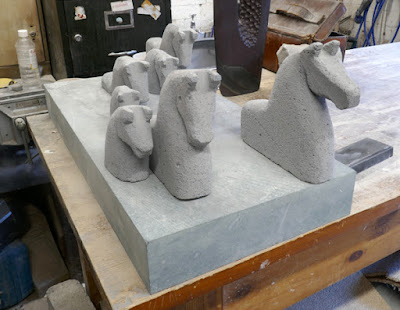 |
| The chapel by Samuel Worth at Moorgate Cemetery |
Following my trip to Bolsterstone at the beginning of February 2023, my next day out coincided with one of the regular sessions that Janet Worrall arranges at the Grade II Listed Boston Park, where the Friends of Moorgate Cemetery are clearing the cemetery of vegetation and restoring a sunken garden known as The Dell.
Since meeting Steve Roche at his workshop in Sheffield, I had arranged for Janet to meet him to discuss her idea of having a sculpture made from the Rotherham Red sandstone that had been retained after excavations for the new reservoirs at Boston Park. She had also asked me if I could come to have a look at The Dell, which she thought may originally have been a quarry.
Based on my experience of the geology of Boston Park and Canklow Woods and looking at the LIDAR map, I didn’t think that it was a quarry but it gave me a reason to get out of the house and have a quick look at the monuments in the Grade II Listed Moorgate Cemetery – especially since my friend Catherine from the Sheffield U3A Geology Group had asked me to give a talk on ‘gravestone geology’ for the Bolsterstone Graveyard Project later in the year.
A quick look at The Dell confirmed my original thoughts and I then proceeded to look for the many Commonwealth War Graves Commission (CWGC) headstones that can be found in Moorgate Cemetery, which I will describe later, as well as examples of granites and marble that might help me with my November talk.
The cemetery opened in 1841 and, as I had seen at several Victorian cemeteries in Sheffield, the earliest memorials consist of large slabs of fine grained sandstone, which I presume come from quarries in Sheffield where the Brincliffe Edge Rock – a local name for the Greenmoor Rock – was worked for top quality headstones.
On this occasion, I was more interested in the numerous pink, red and grey granites and, as with St. Mary’s churchyard in Bolsterstone, I was reliant on Dr. Eric Robinson’s London Illustrated Geological Walks and my old Natural Stone Directory to help me with the identification of these.
As a specialist in stone matching, a skill that I learned when establishing Triton Building Restoration Ltd, I bought the large glossy hardcover book entitled Decorative Stone: The Complete Sourcebook by Monica Price after visiting Leeds Minster. I have to say that partly because it concentrates on the Corsi Collection, which has an emphasis on stones used by the Romans, it doesn't really help geologists like myself who advise on the best stone that could used for the restoration of historic buildings and monuments in the UK.
A geologist colleague Peter Kennett, who spent most of his working life at High Storrs school in Sheffield, produced a guide to building stones aimed at pupils of all ages, which is designed to be used in town centres and graveyards or cemeteries where the stones illustrated are common.
In the part of the cemetery between the entrance and the chapel, the larger later Victorian and Edwardian monuments, which include crosses and obelisks, are made from Scottish pink and grey granites that include varieties from Peterhead, Rubislaw and Kemnay, which are all from the area around Aberdeen and were formed during the Caledonian Orogeny – aprroximately 475-390 million years ago (Ma).
Moving away from the oldest part of the cemetery, I noticed that several headstones and kerbs ranging from 1935 to 1944 are made in grey granite from the Cornubian Batholith under Cornwall and Devon, which was formed during the Variscan Orogeny approximately 280 Ma.
The grey granites are mainly composed of quartz, plagioclase feldspar, alkali feldspar, biotite mica and muscovite mica, with these varying in quantity where exposed in the various plutons spread across the district. Those that I have seen tend to have quite large phenocrysts of white alkali feldspar, but the textures again can be extemely variable.
The monument to James Yates (1881) is built with a massive sandstone that has been used to form four large obelisks set on large plinths, which are linked by iron railings that were made in his foundry. Although thick slabs of Greenmoor Rock at Brincliffe Edge in Sheffield were used for more substantial monuments, in addition to traditional headstones, the railway connections to West Yorkshire were by now well established and it is probable that the sandstone for this monument came from onf the quarries there.
I wasn't taking much notice of the later C20 headstones in the cemetery, but a couple of these did catch my eye. Firstly was the headstone of Charlotte and William Binney (1965), which is made with volcanic green slate from the Borrowdale Volcanic Group in Cumbria and the granite headstone dedicated to various members of the Elmhirst family.
Although I could see from its mineralogy and texture that it is a high grade metamorphic rock, I had no idea where this very attractive and distinctive rock came from; however, trying Google Lens, which I had used once to try and identify a granite without much success, the search results came up with Paradiso or Indian Juparana granite from the Tamil Nadu state in the very south of India – a 1.8 billion year old migmatite formed by partial re-melting of granite and slate.
On this occasion, I just had a quick wander around the cemetery to take a few general photos of the different variety of stones that I encountered, without looking at any of them in any detail. Before leaving the cemetery, I stopped at the Cross of Sacrifice, which is made in a medium grained sandstone that is quite likely to be Stancliffe Darley Dale stone, which is often used for the CWGC headstones in South Yorkshire.




























































